Edwin “Ted” Walker:
Forgotten American Hero & Man of the Right
Morris van de Camp
If you’ve heard about Major General Edwin “Ted” Walker (1909-1993), it is likely in the context of the Kennedy assassination. There are a number of conspiracy theories that accuse Walker of having a role in the plot to slay JFK, and a 1964 movie called Seven Days in May featured a Walker-like character, US Air Force General James Mattoon Scott (Burt Lancaster), attempting to carry out a Deep State coup against an idealistic, peace-loving President who just happened to resemble JFK’s supporters’ idea of him.
Major General Walker’s actual involvement in the Kennedy assassination, if one can call it “involvement,” is in fact nothing more than further evidence supporting the Warren Commission’s official version of events. On the night of April 10, 1963, Lee Harvey Oswald – a self-radicalized precursor to the battalions of violent antifa activists we see today – attempted to assassinate Walker, missing his head by an inch. Oswald had planned the attack for months, even before purchasing his Italian-made rifle. We know that Oswald was behind the attempt on Walker as well as the Kennedy assassination, since the bullets recovered at both scenes were of the same type and bore the same ballistic markings.
Edwin Walker is an interesting figure. He was a bona fide war hero. In addition to his being fictionalized in Seven Days in May, the 1968 film The Devil’s Brigade is very, very loosely based on a combined US-Canadian commando unit Walker commanded in Italy and elsewhere during the Second World War. And as commander of the Arkansas Military District in 1957, he also integrated Central High School in Little Rock, Arkansas by force of arms, but later came to profoundly regret his actions and became a politically active member of the Right. As a side note, Walker was almost certainly an active homosexual.
Major General Walker must be understood within the circumstances of his times. There are two different, but interconnected, social movements that drove this highly talented man to the political Right. The first was the Cold War. The second was the increasingly troublesome Negro Revolution of the 1960s that is misnamed the Civil Rights Movement. All of this occurred during the rather intense institutional transformation of the US Army between the Korean and Vietnam wars. Walker was relieved of command of the 24th Infantry Division due to his political activities. He then resigned from the service and became a political activist throughout the remainder of his life, although he became less effective in this regard as he got older. A lifelong smoker, he died of lung cancer at the age of 83 in Dallas. Given that the politics of the Cold War and of “Civil Rights” continues to influence our society today, Walker’s generalship and later career should be examined.
The story of Edwin Walker’s final years in the military and his political activities, as well as the responses to them, are a factor in why it has become routine for the American military to get involved in long-running, unsatisfying quagmires such as Vietnam, Iraq, and Afghanistan. Frustrated by the quagmire of America’s involvement in Iraq when compared to the successes of the Second World War, the author Thomas Ricks asked, “[H]ow did we go from a tough-minded thinker like George Marshall, who made his reputation in part by speaking truth to power, to eminently pliable chairmen of the Joint Chiefs of Staff such as Air Force Gen. Richard Myers, chairman from 2001 to 2005, and his successor, Marine Gen. Peter Pace, who was chairman for two years after him?”[1]
A large part of the answer comes in the form of the Kennedy administration’s dismissal of General Walker. But before we get into Walker’s controversial tour as commander of the 24th Infantry Division, one must discuss the US Army as an institution and how it evolved up to the time of President Kennedy.
Going Atomic: Walker’s Army, 1931-1961
When Walker graduated from West Point in 1931 and became an artilleryman, the US Army was a small constabulary force scattered across small garrisons. Promotion was slow. Officers were lucky to make Major, and it was possible for a soldier to be a Private for twenty years. Of the enlisted men, it was not unusual if they had never been educated past the eighth grade. Military Occupation Specialties (MOS) were few – cavalry, infantry, artillery, and so on.
Walker and his colleagues in that small cadre proved to be invaluable during the Second World War – Walker in particular. Walker’s record during that war was valorous. But despite the Army’s crucial contribution to America’s victory in that war, once the atomic bomb entered the scene, military planners became convinced that this weapon rendered the Army as obsolete as a charge of cavalry lancers had been in the previous war.
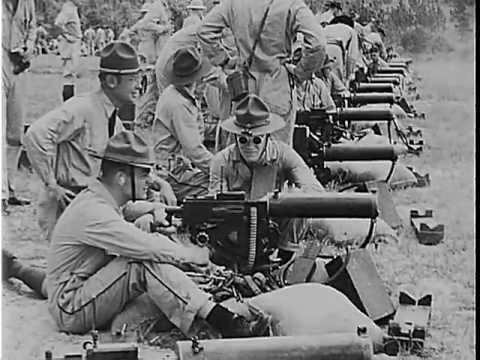
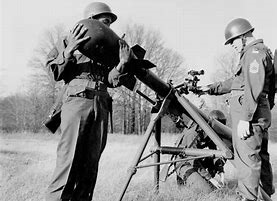
When Edwin Walker joined the Army, the most powerful weapon a team of infantry could wield was a machine-gun (top). When he became Division Commander, the infantry was equipped with the Davy Crockett (bottom), a recoilless rifle that fired a tactical atomic warhead. It was fielded across West Germany, but the weapon had serious technical flaws. It was withdrawn from service by the end of the 1960s. Walker had to keep abreast of vast technical upgrades and apply them to military operations throughout his time in the service.
During the 1950s:
. . . the army seized on the vision of a great atomic land war against the Soviet Union. It quickly adopted a radically new way of fighting – one that required fundamental changes in its equipment, concepts, and training. It reconfigured its historic regiments into “pentomic” battle groups, the Madison Avenue moniker an advertisement for their atomic mission. It designed and deployed everything from sleek air defense missiles to a tactical atomic weapon small enough to transport on a jeep. It trained hundreds of thousands of soldiers in how to employ this equipment and an equal number of technical specialists in how to maintain it.[2]
In the 1930s, a soldier in the Army had few career options; in the 1950s, a soldier could be working on maintaining the electronics on the most advanced rocket in the world. Attracting high-IQ recruits with high school degrees thus quickly became essential.
Major General Walker focused on training his men in the new, atomic way of fighting. “[W]hen Walker took over,” wrote one of his soldiers, “it was like a tornado hit, it was PT every morning, field problems, etc. I could mark a mine field in my sleep; any PFC was able to fill out a morning report.”
Ultimately, the military realized that tactical nukes were not a viable solution to the problem of a Soviet invasion, and the Army’s traditional, conventional role remained necessary. Men like Edwin Walker kept this institution trained to a high standard during a period of tense international conflict. Those who were positioned on the front lines of the Cold War never made any serious mistakes. None of their tactical nukes were ever accidentally detonated, and none found their way into the arsenals of the rapidly proliferating terrorist groups in Europe and the Middle East at the time. A talented and ambitious young man who was drafted into the US Army during this period discovered that the experience was rewarding in the end.
The Cold War
It is important to remember that although Walker’s tenure as Division Commander in West Germany from 1959 to 1961 was not a combat deployment, the situation was nevertheless quite serious. Soviet troops were positioned to invade through the Fulda Gap, and they vastly outnumbered the Americans and their allies in Europe – hence why tactical nukes were deployed in the first place. One veteran described this period thus: “It was a peacetime army, but with unannounced alerts and long term field exercises, there was always an air of tension and there was that very military feeling of living in the middle of events beyond your own control.”
It wasn’t until after the completion of the Berlin Wall in 1961 and the Cuban Missile Crisis in 1962 that the balance of power between the two adversaries in Europe would stabilize and the Communist world would begin to slowly decay, but nobody knew this at the time, of course. During Walker’s time, Communism was on the march. And like William Dudley Pelley, who watched the rise of the Jewish Bolsheviks while in Russia and subsequently became radicalized, Walker became radicalized while watching the Communists make advances when he was working the “Greek Desk” at the Pentagon, and when he was in Greece itself during the Greek Civil War of 1946. Walker also served in the Korean War, a conflict that brought home to Americans the very real threat of Communism, as well as of those forms of Leftist political ideology that helped the Communists to advance. It was during the Korean War that George Lincoln Rockwell also entered politics, following a period of study and reflection upon what was happening at the time.
Communist successes didn’t simply rely on Red Army battalions. Communism had a well-developed package of ideas that could be transmitted universally. Were you laid off? Try Communism! Hungry and war-weary? Peace! Land! Bread! Alienated? Communism will make you feel welcome and part of a community. It was intoxicating to many, and during the 1960s the failures of Communist societies were not as well-known or as pronounced as they later became. It was possible to believe that they might really have the solutions many were looking for. So when Walker took command of the 24th Infantry Division, he instituted a metapolitical counter-Communist ideological campaign called pro-Blue, which was carried out by his information officer, Major Archibald E. Roberts (1915-2006).
This campaign was effective. One soldier later wrote, “I have always wondered what impact [the pro-Blue] experience had on my now right leaning view of the world.” Another wrote:
Never thought of him as a “right wing fanatic” nor do I today. Thought of him as very patriotic, got the division in great shape (mandatory PT and runs daily) and to tell you the truth never did see any racist attitudes come from him (most of my NCO’s were black or Hispanic) and we received great field training. He may have been a little extreme, in some people’s eyes, but most of the men did not think so.
During the Cold War, effective anti-Communist activities were always quickly criticized by the mainstream press. Thus, the pro-Blue program was attacked by the Overseas Weekly, a soft-core porn paper that assumed the perspective of the drafted, junior enlisted soldier in its news articles and editorials. The Overseas Weekly claimed – probably correctly – that Major General Walker was distributing materials from the anti-Communist John Birch Society among his men which claimed that some elected government officials were Communists, and that Walker was also instructing his troops on how to vote. As a result, Secretary of Defense Robert McNamara fired Walker. Walker considered taking the next job offered, a plum assignment in the Pacific, but resigned his commission and embarked on a career of anti-Communism and pro-segregationist political activity.
Integration
While Edwin Walker’s Army was transforming from the rough, uneducated bunch of the 1930s to a highly-skilled cadre of technical troops in the 1950s and early ‘60s, it was also racially integrating. In the 1930s, the US Army maintained separate units for blacks and whites, although the black units were usually commanded by white officers. From 1948 through the 1950s, the Department of Defense worked diligently to ease blacks into white units, a process which is still ongoing with EO Commissions, affirmative action, and so on.
This served several purposes. The first is that all-black units were very uneven. These ranged from effective, such as the 332nd Fighter Group (Red Tails), as well as the 9th and 10th US Cavalry regiments; to marginally effective, in the cases of the 92nd and 93rd infantry divisions; to entirely ineffective, as in the 477th Bombardment Group; to units which had a history of mutiny and mayhem, as in the cases of the 96th Engineer Battalion, and the 24th and 25th US infantry regiments. Breaking up the black units diffused and individualized those problems.
Another purpose was to beef up the combat units. Many black soldiers worked in support jobs, so truck companies were filled to one hundred ten percent-plus capacity, while line infantry companies were often at seventy percent strength.
And lastly, the military is the perfect organization in which to carry out social experiments. It’s a restrictive culture in which orders have to be followed that can make – or at least appear to make – accomplishments in social endeavors. Once the military integrated, pro-integration politicians could contradict the claims of segregationists by pointing out that all was working well in the military. Additionally, they could then use the military to integrate anything else by force.
While Walker was rumored to have thrown a black man out of the officer’s mess in Italy during the Second World War, those who served with him said he didn’t engage in any race-realist activism as a soldier, nor did he otherwise mistreat non-whites. In fact, as a senior leader in the US Army in the late 1950s, Walker was a racial integrator, including his role in the integration of Central High School in Little Rock, Arkansas.
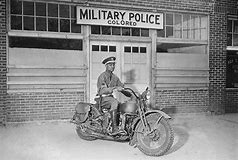
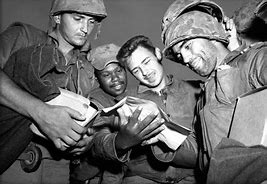
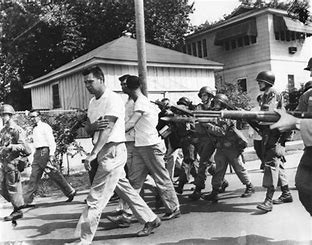
Edwin Walker’s career spanned the desegregation efforts of the American political elite, which began in the 1930s and culminated in the late 1950s. Integrationists used the military as a beta-test for integration and then used the military to integrate society.
Walker’s Right-Wing Activities
After resigning from the Army, Walker ran for Governor of Texas in 1962 as a Democrat. He was defeated in the primary. Shortly thereafter, he joined with Reverend Billy Hargis on an anti-Communist crusade called Operation Midnight Ride. In 1963, Walker led the anti-integration efforts at the University of Mississippi. This put him in direct conflict with people he knew personally in the Kennedy administration, as well as the Democratic Party’s elite. After Mississippi, the Kennedy administration attempted to have Walker consigned to a psychiatric ward.
President Kennedy was killed in late 1963, and Walker’s ongoing efforts were then overshadowed by the escalating events of the period, including the Vietnam War, race riots, and Watergate. By the end of his life, Walker was considered an out-of-date crank. Nonetheless, what he did as a Rightist deserves a great deal of reflection.
The first thing that stands out is the timing of when Walker developed his segregationist attitudes, given that he had been actively engaged in integrationist efforts prior to that time. Walker wasn’t looking backwards when he became a segregationist, but forwards, reflecting a gathering white racial consciousness.
Furthermore, Walker was going against two decades of mainstream opinion. The earliest desegregation efforts began in the courts and the media in the early 1930s. The first true desegregation case is Missouri ex rel. Gaines v. Canada, which was decided in 1933. Restrictive housing covenants were struck down in the 1940s. Brown vs. Board of Education happened in 1954, which is also when Congress passed the Civil Rights Act. During the integration crisis at Little Rock, Walker was positively profiled by The New York Times, but when he came out as a segregationist, his positive coverage evaporated. His politics cost him dearly.
One can only conclude that Walker looked at the results of desegregation and changed his mind about it at great personal and professional cost. We can only speculate as to his reasons, but they likely stemmed from believing that desegregation had gone too far with school integration, and that desegregation was harming American society and damaging American interests during the Cold War.
In 1957, desegregation required the resources of an entire Military District and a crack paratrooper division. Although the integrationists won at Little Rock, it nevertheless marked the start of white resistance to it rather than a proverbial “last gasp.” Walker understood this; the Kennedy, Johnson, and Nixon administrations did not.
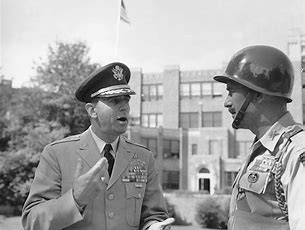
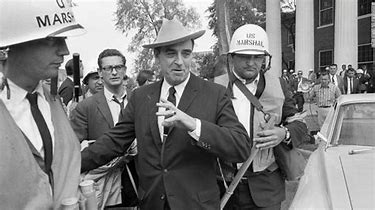
Before and after: Edwin Walker integrated Central High School in Little Rock, Arkansas in 1957 (above). In 1963, Walker joined the segregationists (below). His intellectual journey has never really been remarked upon.
As for Walker’s pro-Blue actions, one can only conclude that his campaign did work. The only flaw in it was that it likely used John Birch Society pamphlets rather than more substantial works. The John Birch Society was a bit of a fraud; in particular, they never mentioned the JQ. And indeed, Revilo P. Oliver resigned from the Society over the organization’s ineffectiveness. Additionally, much anti-Communist propaganda of the period cast too wide a net, accusing innocent people of Communist ties. In war, truth must be shrouded in a bodyguard of lies; in a war of ideas, lies cannot be used at all.
Edwin Walker’s career in the military provides a partial answer to why there is so much mediocrity among America’s flag officers of today, as pointed out by Thomas Ricks. As a Division Commander, Walker didn’t just train his men to fight Communists; he implemented a serious campaign to explain why they should fight Communists. He was fired for this, and the other generals got the memo. In the Global War on Terror, there has not been a similar effort to attempt to explain to soldiers the reasons why the war should be fought. Today’s officers are more bureaucrats than thinkers.
In the end, Walker was right that racial integration would cause a great deal of problems for American society. While there have been some successes, on the whole, the Civil Rights Movement emancipated nothing but savagery – although nobody can say this, of course. And regardless of how successful Walker’s anti-Communist activities were, it must be noted that he lived longer than the Soviet Union did.
Notes
[1] Thomas E. Ricks, The Generals: American Military Command from World War II to Today (New York: Penguin Books, 2012), Prologue.
[2] Brian McAllister Linn, Elvis’s Army: Cold War GIs and the Atomic Battlefield (Cambridge: Harvard University Press, 2016), p. 4.
Edwin%20and%238220%3BTedand%238221%3B%20Walker%3A%20Forgotten%20American%20Hero%20and%23038%3B%20Man%20of%20the%20Right
Enjoyed this article?
Be the first to leave a tip in the jar!
Related
-
Crusading for Christ and Country: The Life and Work of Lieutenant Colonel “Jack” Mohr
-
Enlisting in the Military: A Very, Very Bad Idea
-
The Establishment’s Radicals
-
Fascism in Texas, the Inalienable Right to Nappy Hair, and Other Fertilizer from the Mainstream Media
-
Bo Gritz, Vietnam Veteran and Military Adventurer, Part 1: 1939-1986
-
The Buoyancy of Psychopaths and the Genesis of the Great Asian War
-
A Conspiratorial Life
-
The Terrible Loss of an American Patriot
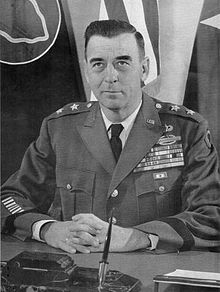
16 comments
‘These ranged from effective, such as the 332nd Fighter Group (Red Tails)’
Nope.
Propaganda son
And a massive insult to the Polish airmen.
Try again.
Polish pilots are beyond the scope of this article.
In so far as the Red Tails. I’ve looked at them for more than 10 years. In fact, a prominent movement leader asked me to do so. What I’ve found is the following:
The Tuskegee Airman program as a whole produced uneven results. The fighter pilots did their jobs as bomber escorts. The Negro bomber pilots and crews never got it together.
Excellent. This great man has so often been bowled over by pop history.
No need to knock the JBS in the late 50s or early 60s; they were almost entirely good people.
Please name the innocent people who were falsely accused of communist ties?
Alger Hiss?
A simple google search will show who was accused but not actually a Communist. Wild accusations did not help during the Cold War. In the 1950s and 60s there was a robust group of Anti anti-Communists. This group was pretty effective. Any person accused of being a Communist and no proof was offered gave ammunition to the Anti anti-Communists.
I believe that MG Walker should have been more careful with his pro-Blue campaign. He should have been translating the works of French Rightists rather than using the JBS materials. The French Right was then and is now light years ahead of the Americans in dealing with Jacobin lunacy.
To get the details, of who was really a Communist, I suggest a google search of the Verona Project or read Ann Coulter’s book about Senator McCarthy.
Good to read some research on the forgotten Rightist legacy.
Major Arch Roberts wrote a book of his experiences with the pro-Blue project and its scuttling : Victory Denied. He and Walker were among what seems to have been a quite large number of military officers involved in the Right.
Relegation to a psychiatric institution was a tactic of the Kennedy Admin. for Rightists, and the place was at Springfield, Missouri. Seelig, a veteran journalist, wrote of his horrendous experiences at the institution in Destroy the Accuser, which had a foreword by Revilo Oliver. James Forestall might have paid the ultimate sacrifice. This was the time of MK-ULTRA.
In regard to false accusations about Communists; the CIA had a plan to feed McCarthy false information through an intermediary, to discredit him. This ‘conspiracy theory’ can be read about at the CIA’s website. Nonetheless, now even Leftists admit that most of what McCarthy said was accurate. At the time there was conflict between the CIA and the FBI. The assumption that the CIA were avid anti-communist warriors is a myth. The real worry about McCarthy was that he was not only going after Soviet agents but, thinking he was on a trail of Red agents, he was about to go after highly placed Establishment figures such as Cord Meyer, who was not a Communist, but a globalist close to the centers of power, and a leading figure in the CIA’s recruiting of Left-wing students.
The JBS material was quite good, as Margot Metroland indicates. If the USA was involved in a war against Communism why were Walker, MacArthur, McCarthy, et al purged? It is, I think, because the USA was the center of a world revolution that was being countered by the pan-Slavism of the USSR, to the point where Trotsky’s widow Natalia Sedova, quit the Fourth International over the issue of the Korean War, and other Trots and disaffected Marxists flocked to the U.S. side, via the Congress for Cultural Freedom and others. The New Left was created by the USA to subvert Soviet influences among youth, and for other purposes.
What Walker was doing was trying to present an ideological – nationalistic – alternative to Communism through the Pro-Blue program . This was anathema to the ‘Establishment’, whose ideology was more Bolshevik than the USSR. What was NOT wanted was a multitude of nationalistic ex-soldiers returning to the USA with political ideas that ran counter to the Establishment.
At the time , odd as it now seems, The John Birch Society was regarded with fear and loathing by the Establishment, and a huge amount of time was spent by the FBI keeping it under surveillance, presumably on orders from the Attorney General. This was a time as well when Senator Barry Goldwater was enough to send the Establishment into fits of fear, and the fact that his rival for the Republican presidential nomination was Nelson Rockefeller, says something about the ideological lineup, and what – Right or Left – constitutes the real anti-Establishment revolt.
Worse still, Walker’s involvement in opposing school integration was regarded as tantamount to a Southern insurrection.
Thank you for the context and explanation. It brings more big picture to Walker’s profile.
Interesting person, but am I missing something?
What did he DO?
I understand that he had some kind of transformation, but then what? He ran for governor of Texas? Who did he talk to? Who was he trying to convince? How much support did he get?
This article raises more questions than it answers.
Is there anything to be learned from Gen. Walker’s failures?
Off-topic, but could be of use to you Mr. de Camp, as it pertains to the time period in question – and maybe your interest in general.
http://lib.msstate.edu/digitalcollections/citizenscouncil/
From 1957 to 1966, the White Citizens Councils hosted a radio show. It’s all been transcribed and digitized.
I’ve been listening to bits and pieces, and it’s fascinating. The author of the project, Stephanie R. Rolph, wrote a book about her research. You can find her Twitter here: https://twitter.com/stephanie_rolph?lang=en.
Her work, and these tapes, would be an interesting dive for someone with the time and inclination to write about them.
Thanks for the info.
As far as your questions: Walker wasn’t a failure. He also deserves a biography, but there isn’t one on him yet so the full story isn’t out there yet.
How was he “almost certainly and active homosexual”?
He was arrested in a men’s room for lewd conduct several times. There is also some theories out there on how his sexuality might have influenced he’s politics, but I chose to not comment on them.
@ Morris
Wow, I never heard that before. I’m surprised his enemies didn’t use that against him; seeing as how they made fun of that at the time. Supposedly, a similar type of ex-military activist, one Gen. John G. Cromelin, had accused the late Eustace Mullins of such a thing, but it was largely rejected by most.
It was used against him. While I had not heard about Admiral Crommelin accusing Eustace Mullins, at the time this was a tactic used widely by the FBI as part of its COINTELPRO actions against the Right. Mullins was stated by the FBI to be homosexual, and even Benjamin H. Freedman, at the time married and elderly. Another tactic was to spread rumours about affairs and embezzlement. The Klan was a particular target. The COINTELPRO files have been released under Freedom of Information and are online.
Concerning the CIA, Revilo P. Oliver was under no illusions about its highly questionable loyalty to any real defense of the West against communism. He said that many knowledgeable persons at the time referred to its World War II embryo (the OSS, or “Office of Strategic Services”) as the Office of Soviet Stooges.
Another May 7th has come and gone 55 years after John Frankenheimer’s movie about an attempted military coup in the USA…
Seven Days in May was made in 1964 but is set circa 1970. Yet it’s a 1970 which has little relation to the actual America of that year. There are no long haired hippies, no inner city rioters, no student radicals taking over campuses, no Woodstock love-ins, and certainly no Vietnam War. It’s still a country where the protesters in front of the White House wear white starched shirts while fashionable hostesses serve cocktails at DC parties instead of leftist agitprop.
It shows how rapidly things can change – especially in politics. 1964 was at the precipice of the Berkeley Free Speech Movement, the Immigration and Nationality Act, the US commitment of combat forces to Vietnam, the White backlash which led to the rise of George Wallace and Richard Nixon.
Seven Days in May deals with real issues and there is a case to be made that the film gives General James Mattoon Scott (Burt Lancaster) a speech which reveals the truth that can only be spoken by the officially designated villain:
And if you want to talk about your oath of office, I’m here to tell you face to face, President Lyman, that you violated that oath when you stripped this country of its muscles – when you deliberately played upon the fear and fatigue of the people and told them they could remove that fear by the stroke of a pen.
The irony is that the ensuing rhetorical defense of constitutional government by President Jordan Lyman (Fredric March) sounds archaic today given how the electoral process has long since been usurped by campaign mega-donors, the Deep State and the IT-infotainment-Leftist complex. Lyman states:
The enemy’s an age – a nuclear age. It happens to have killed man’s faith in his ability to influence what happens to him.
What’s killed Western man’s faith for the 21st century is no longer the nuclear age but the assaults on religion and tradition, the obvious hostility of globalist elites, the submergence of nations into a lunatic new world order.
Leftist cinematic concerns over Seven Days in May style military coups, Manchurian candidate assassinations, and Ripper-esque SAC commanders launching unauthorized nuclear strikes appear odd given that the Pentagon pretty much went along with the limited war strategy which had disastrous consequences in Vietnam. Despite official proclamations of being the “counter-culture” or “resistance,” the Left has been and continues to be the Establishment, something which the current commander-in-chief has no doubt discovered during his tour in the White House.
What the Left/Deep State Establishment fears is not the overthrow of the Constitution (they’ve already accomplished that!) but rather that some organized sector of the traditional American people will wake up and take action. The real threat posed by a General Walker was that he understood the ideological menace of communism (both foreign and domestic) and that the only way to combat that menace was with an American ideology.
For 2019, one can pose an ideology of White Nationalism against Globalization. And consider where things will be in another decade.
Comments are closed.
If you have Paywall access,
simply login first to see your comment auto-approved.
Note on comments privacy & moderation
Your email is never published nor shared.
Comments are moderated. If you don't see your comment, please be patient. If approved, it will appear here soon. Do not post your comment a second time.
Paywall Access
Lost your password?Edit your comment